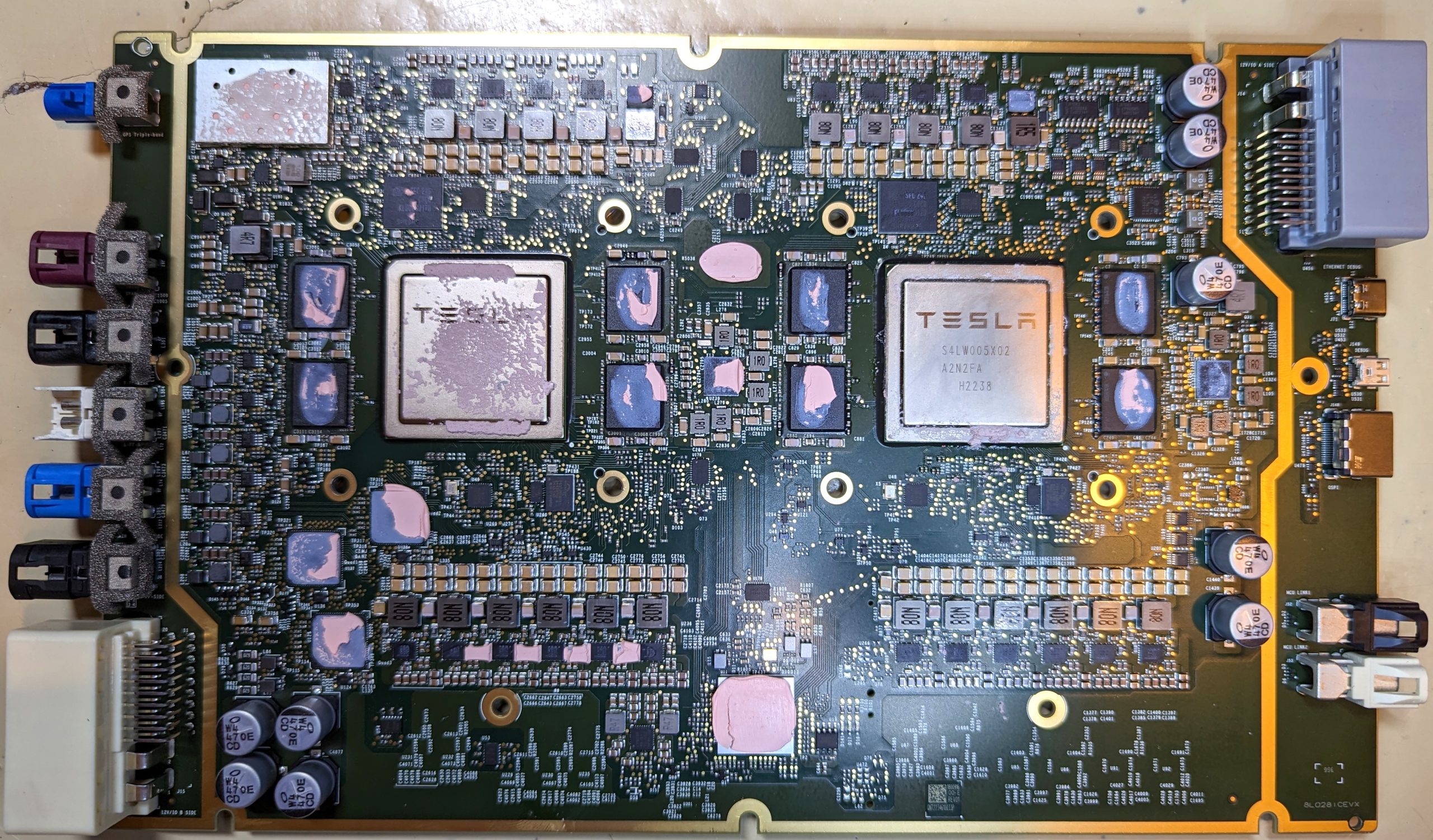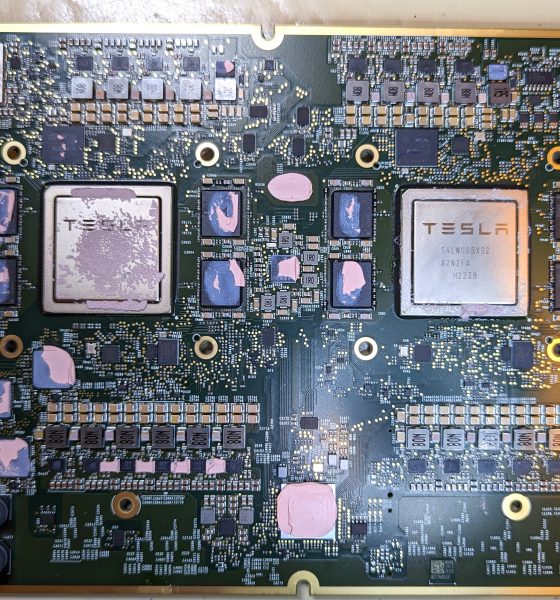New images and details surrounding Tesla’s most robust self-driving computer, or Hardware 4 (HW4), were shown today, revealing additional cameras, a reintroduction of potential radar systems, and more.
Tesla released some details about HW4 during last year’s AI Day event. Still, additional specifications were revealed today by Greentheonly, a Tesla hacker who said the computer came from a Model X vehicle. Green said that Tesla has already started building vehicles with the new computer, but they are not yet being delivered.
I am sure you are all eager to know more about HW4, so I am going to show you the refreshed car computer from a Model X. Just don’t tell anybody you saw it, because it’s really a secret still.
This unit made appearance at the EPC about a month ago, but the picture was hidden. pic.twitter.com/7AENqP6h2Z— green (@greentheonly) February 15, 2023
Right off the bat, green confirms what CEO Elon Musk said during the most recent earnings call: retrofits of HW4 into older vehicles will not be possible. While green shows the form factor of the new computer is completely different than past ones, even the most recent applications that were installed in Plaid vehicles, the new HW4 is simply not compatible.
Musk said during the Q4 Earnings Call in late January:
“But it is the cost and difficulty of retrofitting Hardware 3 with Hardware 4 is quite significant. So it would not be, I think, economically feasible to do so.”
Many of the specifics of HW4 are extremely technical, but it appears Tesla aimed to simplify the infotainment system to void a GPU daughterboard. The entire unit is smaller and sleeker, but the RAM, NVMe (nonvolatile memory express), CPU, and GPU are all identical to past units.
Green adds:
“A lot less improvement than many hoped for. Still Samsung Exynos-IP based. Bumped CPU cores from 12 to 20 (5 clusters of 4 cores each), maxing at 2.35GHz, idle at 1.37GHz Number of TRIP cores increased from 2 to 3, 2.2GHz max freq All x2 since there are two SoCs per board.”
HW4:
A lot less improvement than many hoped for.
Still Samsung Exynos-IP based.
Bumped CPU cores from 12 to 20 (5 clusters of 4 cores each), maxing at 2.35GHz, idle at 1.37GHz
Number of TRIP cores increased from 2 to 3, 2.2GHz max freq
All x2 since there are two SoCs per board pic.twitter.com/eeHXg5x0aL— green (@greentheonly) February 15, 2023
Perhaps one of the most notable differences are there are now 12 “fully-populated camera connectors,” with one being utilized as a spare. The cameras are also labeled, and some seem to indicate that cameras will be added to the front and rear bumpers. “There’s a huge blindspot up front on legacy cars up front,” green notes.
What’s SVC you might wonder? According to EPC, SVC is bumper. So I’d guess these are bumper cameras. There’s a huge blindspot upfront on legacy cars up front (welcome to the legacy camp, Plaid owners!), so front bumper camera and two in the (rear?) bumper corners for x-traffic pic.twitter.com/sixzNo7qII
— green (@greentheonly) February 15, 2023
This would make sense, considering Teslas currently utilize eight cameras, with the additional three connectors making way for the two rear and one front camera that will be added with the new hardware.
Another interesting detail found by green was Phoenix radar, which is a rumored 4-dimensional radar that will help extend current reach by double. Tesla wanted to move away from radar, opting for a completely camera-based approach, which it did with the introduction of its Vision model.
Musk said during the Q1 2021 Earnings Call:
“When your vision works, it works better than the best human because it’s like having eight cameras, it’s like having eyes in the back of your head, beside your head, and has three eyes of different focal distances looking forward. This is — and processing it at a speed that is superhuman. There’s no question in my mind that with a pure vision solution, we can make a car that is dramatically safer than the average person.”
However, radar and a radar heater were both seen in vehicle coding. The Phoenix radar appears to be a type of forward radar that will be installed in HW4 vehicles.
Perhaps more details will be shed regarding HW4 in the coming weeks, especially as Tesla’s Investor Day is approaching and will take place on March 1.
I’d love to hear from you! If you have any comments, concerns, or questions, please email me at joey@teslarati.com. You can also reach me on Twitter @KlenderJoey, or if you have news tips, you can email us at tips@teslarati.com.

News
Tesla aims to combat common Full Self-Driving problem with new patent
Tesla writes in the patent that its autonomous and semi-autonomous vehicles are heavily reliant on camera systems to navigate and interact with their environment.

Tesla is aiming to combat a common Full Self-Driving problem with a new patent.
One issue with Tesla’s vision-based approach is that sunlight glare can become a troublesome element of everyday travel. Full Self-Driving is certainly an amazing technology, but there are still things Tesla is aiming to figure out with its development.
Unfortunately, it is extremely difficult to get around this issue, and even humans need ways to combat it when they’re driving, as we commonly use sunglasses or sun visors to give us better visibility.
Cameras obviously do not have these ways to fight sunglare, but a new patent Tesla recently had published aims to fight this through a “glare shield.”
Tesla writes in the patent that its autonomous and semi-autonomous vehicles are heavily reliant on camera systems to navigate and interact with their environment.

The ability to see surroundings is crucial for accurate performance, and glare is one element of interference that has yet to be confronted.
Tesla described the patent, which will utilize “a textured surface composed of an array of micro-cones, or cone-shaped formations, which serve to scatter incident light in various directions, thereby reducing glare and improving camera vision.”

The patent was first spotted by Not a Tesla App.
The design of the micro-cones is the first element of the puzzle to fight the excess glare. The patent says they are “optimized in size, angle, and orientation to minimize Total Hemispherical Reflectance (THR) and reflection penalty, enhancing the camera’s ability to accurately interpret visual data.”
Additionally, there is an electromechanical system for dynamic orientation adjustment, which will allow the micro-cones to move based on the angle of external light sources.
This is not the only thing Tesla is mulling to resolve issues with sunlight glare, as it has also worked on two other ways to combat the problem. One thing the company has discussed is a direct photon count.
CEO Elon Musk said during the Q2 Earnings Call:
“We use an approach which is direct photon count. When you see a processed image, so the image that goes from the sort of photon counter — the silicon photon counter — that then goes through a digital signal processor or image signal processor, that’s normally what happens. And then the image that you see looks all washed out, because if you point the camera at the sun, the post-processing of the photon counting washes things out.”
Future Hardware iterations, like Hardware 5 and Hardware 6, could also integrate better solutions for the sunglare issue, such as neutral density filters or heated lenses, aiming to solve glare more effectively.
Elon Musk
Delaware Supreme Court reinstates Elon Musk’s 2018 Tesla CEO pay package
The unanimous decision criticized the prior total rescission as “improper and inequitable,” arguing that it left Musk uncompensated for six years of transformative leadership at Tesla.

The Delaware Supreme Court has overturned a lower court ruling, reinstating Elon Musk’s 2018 compensation package originally valued at $56 billion but now worth approximately $139 billion due to Tesla’s soaring stock price.
The unanimous decision criticized the prior total rescission as “improper and inequitable,” arguing that it left Musk uncompensated for six years of transformative leadership at Tesla. Musk quickly celebrated the outcome on X, stating that he felt “vindicated.” He also shared his gratitude to TSLA shareholders.
Delaware Supreme Court makes a decision
In a 49-page ruling Friday, the Delaware Supreme Court reversed Chancellor Kathaleen McCormick’s 2024 decision that voided the 2018 package over alleged board conflicts and inadequate shareholder disclosures. The high court acknowledged varying views on liability but agreed rescission was excessive, stating it “leaves Musk uncompensated for his time and efforts over a period of six years.”
The 2018 plan granted Musk options on about 304 million shares upon hitting aggressive milestones, all of which were achieved ahead of time. Shareholders overwhelmingly approved it initially in 2018 and ratified it once again in 2024 after the Delaware lower court struck it down. The case against Musk’s 2018 pay package was filed by plaintiff Richard Tornetta, who held just nine shares when the compensation plan was approved.
A hard-fought victory
As noted in a Reuters report, Tesla’s win avoids a potential $26 billion earnings hit from replacing the award at current prices. Tesla, now Texas-incorporated, had hedged with interim plans, including a November 2025 shareholder-approved package potentially worth $878 billion tied to Robotaxi and Optimus goals and other extremely aggressive operational milestones.
The saga surrounding Elon Musk’s 2018 pay package ultimately damaged Delaware’s corporate appeal, prompting a number of high-profile firms, such as Dropbox, Roblox, Trade Desk, and Coinbase, to follow Tesla’s exodus out of the state. What added more fuel to the issue was the fact that Tornetta’s legal team, following the lower court’s 2024 decision, demanded a fee request of more than $5.1 billion worth of TSLA stock, which was equal to an hourly rate of over $200,000.
Delaware Supreme Court Elon Musk 2018 Pay Package by Simon Alvarez
News
Tesla Cybercab tests are going on overdrive with production-ready units
Tesla is ramping its real-world tests of the Cybercab, with multiple sightings of the vehicle being reported across social media this week.

Tesla is ramping its real-world tests of the Cybercab, with multiple sightings of the autonomous two-seater being reported across social media this week. Based on videos of the vehicle that have been shared online, it appears that Cybercab tests are underway across multiple states.
Recent Cybercab sightings
Reports of Cybercab tests have ramped this week, with a vehicle that looked like a production-ready prototype being spotted at Apple’s Visitor Center in California. The vehicle in this sighting was interesting as it was equipped with a steering wheel. The vehicle also featured some changes to the design of its brake lights.
The Cybercab was also filmed testing at the Fremont factory’s test track, which also seemed to involve a vehicle that looked production-ready. This also seemed to be the case for a Cybercab that was spotted in Austin, Texas, which happened to be undergoing real-world tests. Overall, these sightings suggest that Cybercab testing is fully underway, and the vehicle is really moving towards production.
Production design all but finalized?
Recently, a near-production-ready Cybercab was showcased at Tesla’s Santana Row showroom in San Jose. The vehicle was equipped with frameless windows, dual windshield wipers, powered butterfly door struts, an extended front splitter, an updated lightbar, new wheel covers, and a license plate bracket. Interior updates include redesigned dash/door panels, refined seats with center cupholders, updated carpet, and what appeared to be improved legroom.
There seems to be a pretty good chance that the Cybercab’s design has been all but finalized, at least considering Elon Musk’s comments at the 2025 Annual Shareholder Meeting. During the event, Musk confirmed that the vehicle will enter production around April 2026, and its production targets will be quite ambitious.










